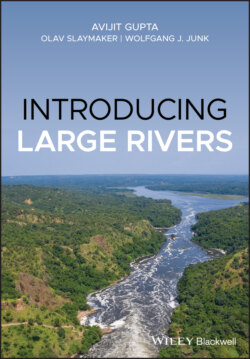Читать книгу Introducing Large Rivers - Avijit Gupta - Страница 36
4.3.3 Sediment Load
ОглавлениеOnly 800 000 km2 of the Andes and Sub-Andes falls within the 7 million km2 Amazon Basin but this area contributes almost the entire sediment load of the river. Throughout the Late Cenozoic, 500–600 million tonnes of sediment arrived annually from this source, although the foreland basins trapped approximately half of the amount to build fans (Mertes and Dunne 2007, referring to Guyot 1993). The foreland basins sag in response to the rise of the Andes, and its erosion, reducing the river gradients to very low figures. Only fine sediment (<0.5 mm) reaches the lowland Amazon flowing within Brazil. No significant sediment is supplied from the old rocks of the Brazil and Guyana shields, but from there a huge volume of water reaches the river. In brief, the main stem discharge of the Amazon is augmented cumulatively by a number of tributaries draining different parts of the basin, but the sediment supply comes almost exclusively from mountains of high relief at the head of the basin with tectonically fractured rocks and oversteepened slopes as described by Milliman and Syvitski (1992). Almost the entire sediment arrives either from the Peruvian Andes along the Amazon main stem or from the Bolivian Andes via the Madeira (Meade 2007). A number of large tributaries have been described as clearwater streams, rising below the Andes they bring little sediment to the Amazon.
Figure 4.4 The Amazon: Generalised geology and course.
Source: Dunne et al. 1998.
Figure 4.5 The Amazon from satellite imagery.
Source: NASA Worldview application (https://worldview.earthdata.nasa.gov), part of the NASA Earth Observing System Data and Information System (EOSDIS).
The average annual sediment load of the Amazon measured at Óbidos, approximately at the tidal limit, is about 1200 million tonnes. A bigger load is carried only by the combined flow of the Ganga and Brahmaputra. However, as calculated by Dunne et al. (1998), who studied sediment transport though the 2010 km of the Amazon in lowland Brazil, a higher amount of sediment is transferred laterally between the channel and the floodplain, and then passed downstream (Figure 3.3). The lateral exchange of sediment involves bank erosion, bar deposition in the main channel, settling from overland flow on the floodplain, and sedimentation in channels within the floodplain. Much of the sediment that leaves the channel in suspension during floods and enters the floodplain is deposited there before clearer water returns to the Amazon during the falling stage of the annual hydrograph. Mertes et al. (1996) estimated that in the reach between the confluences of the Jutai and Madeira with the Amazon, the mean recycling time is between 1000 years and 2000 years. This allows progressive enrichment of quartz grains downstream.
